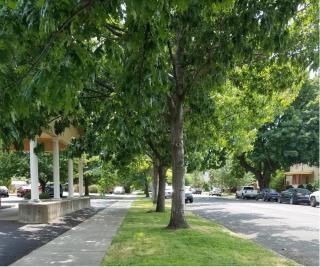Benefits of the Urban Forest

WHY SHOULD CITIES INVEST IN THEIR URBAN FOREST?
Trees are major capital assets in America’s cities and towns. Publicly owned trees are a part of a community’s infrastructure just like streets, sidewalks, sewers, public buildings and recreational facilities. Research from cities across the United States show an average return of $2.00 in benefits provided by trees for every $1.00 invested in stewardship.
The Tree Benefit Calculator allows anyone to make a simple estimation of the benefits individual street-side trees provide: National Tree Benefit Calculator
The urban forest is an important resource for the health our environment. Well placed trees:
- Hold soil in place - preventing erosion
- Absorb storm water that might otherwise pollute our waterways
- Cleanse the air by producing oxygen, and removing contaminants
- Absorb carbon dioxide, the largest greenhouse gas
- Provide shade to cool streets and sidewalks
- Reduce noise pollution
- Provide a wildlife habitat
Urban trees provide economic values to communities, businesses, and homes:
- Urban trees can increase home values by 15 percent.
- Shade trees reduce air conditioning bills.
- Trees and shrubs prevent heat loss from winter winds and save in fuel use.
- Trees enhance community economic stability by attracting businesses and tourists.
- People shop longer and spend more in commercial districts with tree-lined streets.
- Good canopy cover extends the life of asphalt paving on streets.
Social benefits associated with urban forests include:
- More pleasant environments for a wide range of activities
- Improvements in the aesthetic environment (sights, sounds, smells)
- Relief from stress, which can lead to improved physical health
- Enhanced feelings and moods and increased enjoyment of everyday life
- A stronger feeling of connection between people and their neighborhood
- Reduced rates of crime and domestic violence
